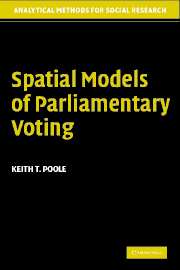Book contents
- Frontmatter
- Contents
- List of Tables and Figures
- Preface
- 1 Introduction
- 2 The Geometry of Parliamentary Roll Call Voting
- 3 The Optimal Classification Method
- 4 Probabilistic Spatial Models of Parliamentary Voting
- 5 Practical Issues in Computing Spatial Models of Parliamentary Voting
- 6 Conducting Natural Experiments with Roll Calls
- 7 Conclusion
- References
- Index
4 - Probabilistic Spatial Models of Parliamentary Voting
Published online by Cambridge University Press: 24 November 2009
- Frontmatter
- Contents
- List of Tables and Figures
- Preface
- 1 Introduction
- 2 The Geometry of Parliamentary Roll Call Voting
- 3 The Optimal Classification Method
- 4 Probabilistic Spatial Models of Parliamentary Voting
- 5 Practical Issues in Computing Spatial Models of Parliamentary Voting
- 6 Conducting Natural Experiments with Roll Calls
- 7 Conclusion
- References
- Index
Summary
Overview
Several probabilistic models of legislative voting have been developed during the past 30 years. In my discussion of the optimal classification (OC) method in Chapter 3, I assumed only that legislators used a symmetric single-peaked utility function. I did not make any assumptions about the functional form of the error distribution or the functional form of the deterministic utility function. OC is simply a nonparametric scaling method that maximizes correct classifications. The downside to OC is that it is difficult to do any meaningful statistical inference beyond straightforward Monte Carlo testing (Poole, 1997; 2000a; b). Determining the statistical properties of OC is an unsolved problem.
Below I make explicit assumptions about the functional form of both the deterministic utility function and the error distribution. These assumptions have consequences – there is no free lunch with probabilistic voting models. Estimation of these models is complicated, and the statistical issues are especially thorny and not fully resolved. The good news is that, despite these drawbacks, the major probabilistic methods produce essentially the same spatial maps for large legislatures (50 or more legislators). This is important from a scientific standpoint, because it means that the basic geometric model of choice that underlies all the estimation methods produces meaningful results.
The major probabilistic models of parliamentary voting are based on the random utility model developed by McFadden (1976). In the random utility model, a legislator's overall utility for voting Yea is the sum of a deterministic utility and a random error.
- Type
- Chapter
- Information
- Spatial Models of Parliamentary Voting , pp. 88 - 127Publisher: Cambridge University PressPrint publication year: 2005
- 1
- Cited by

